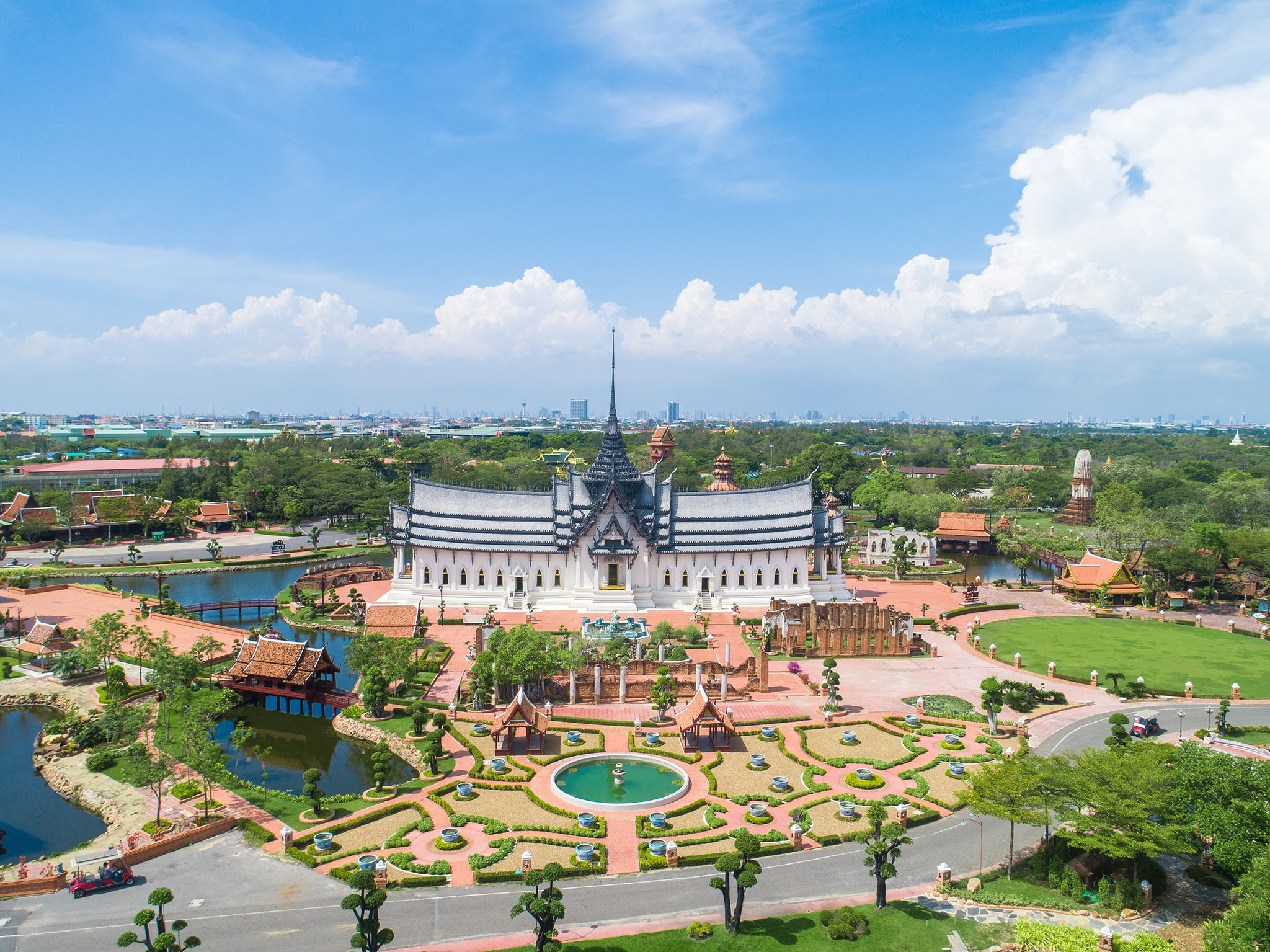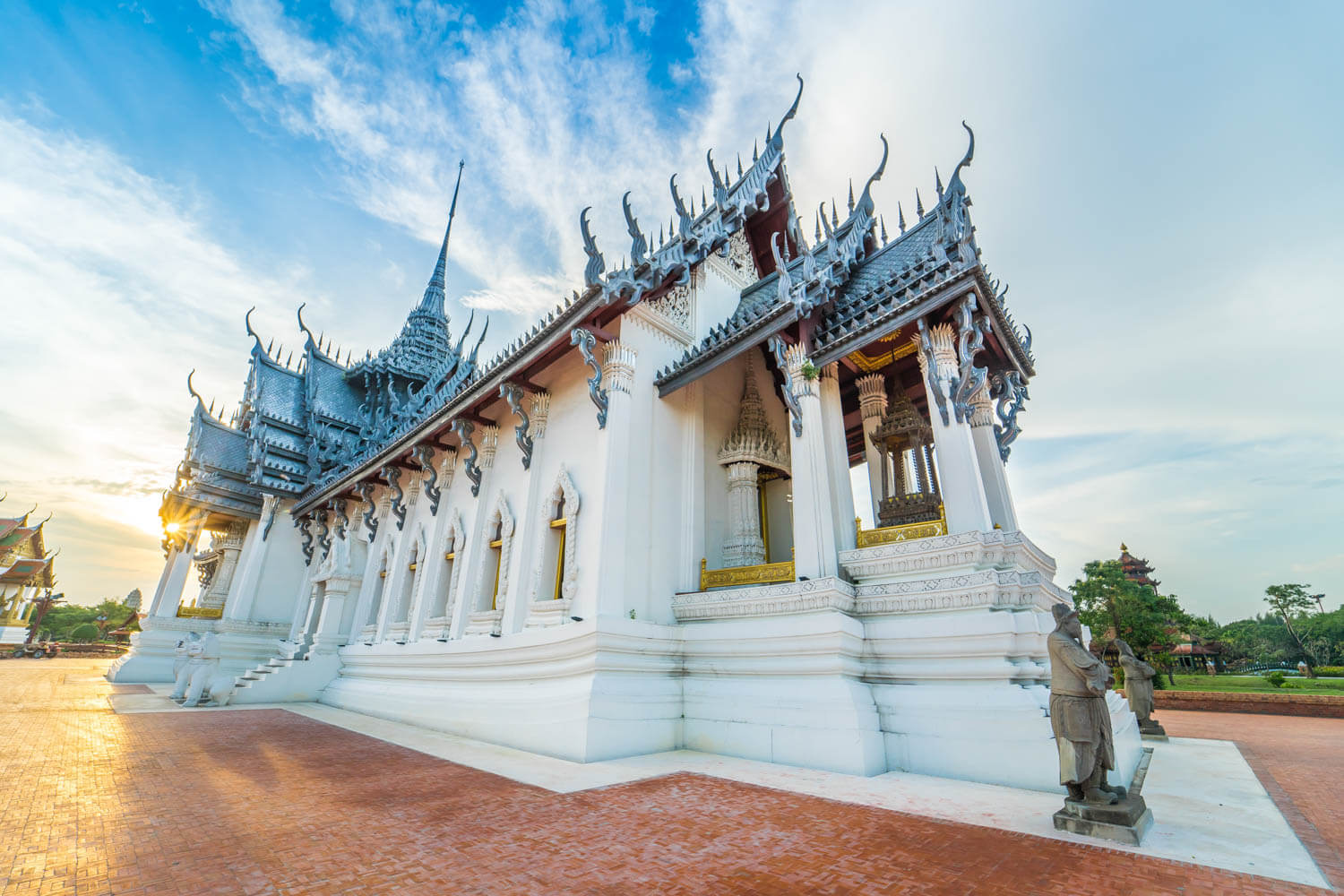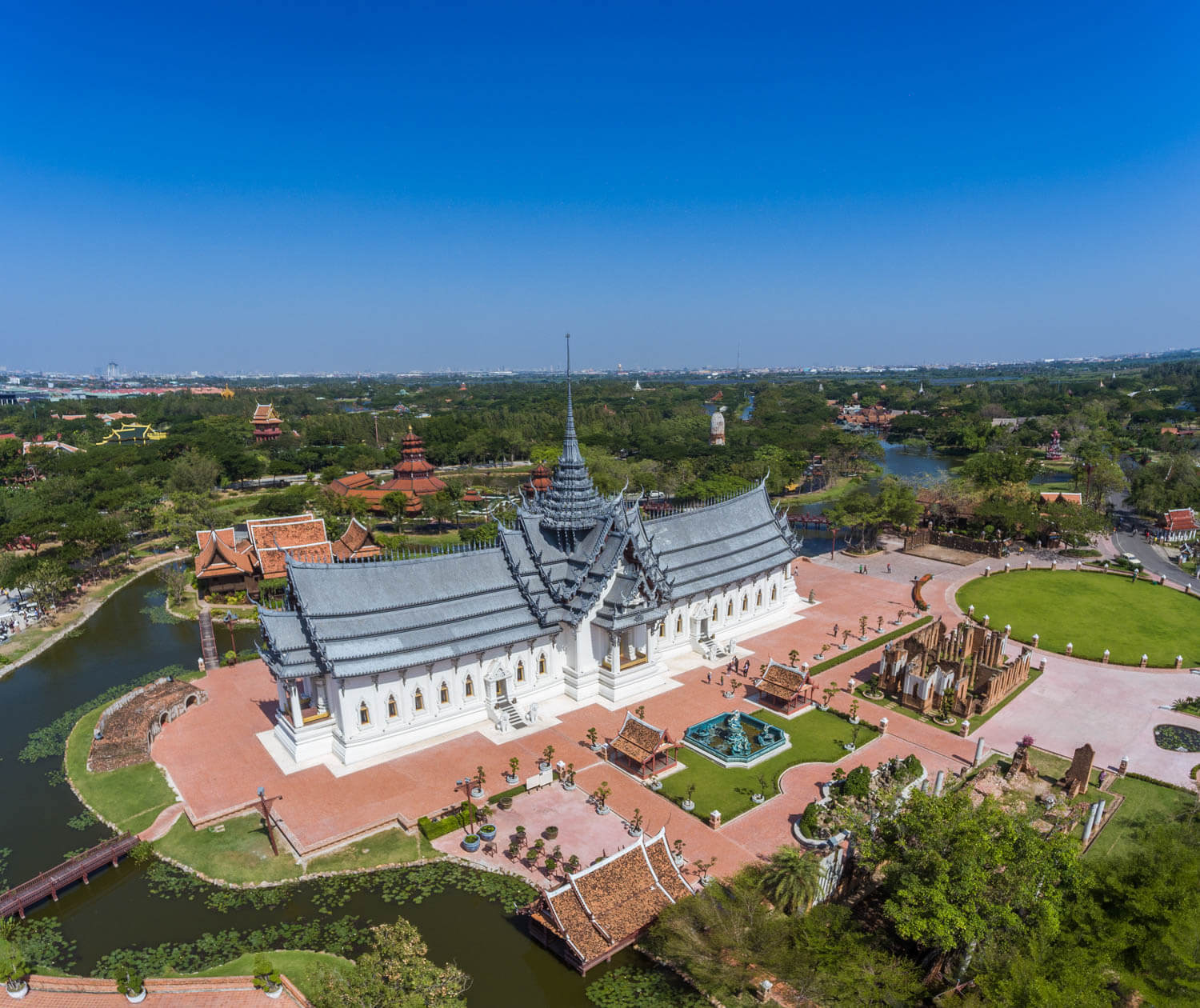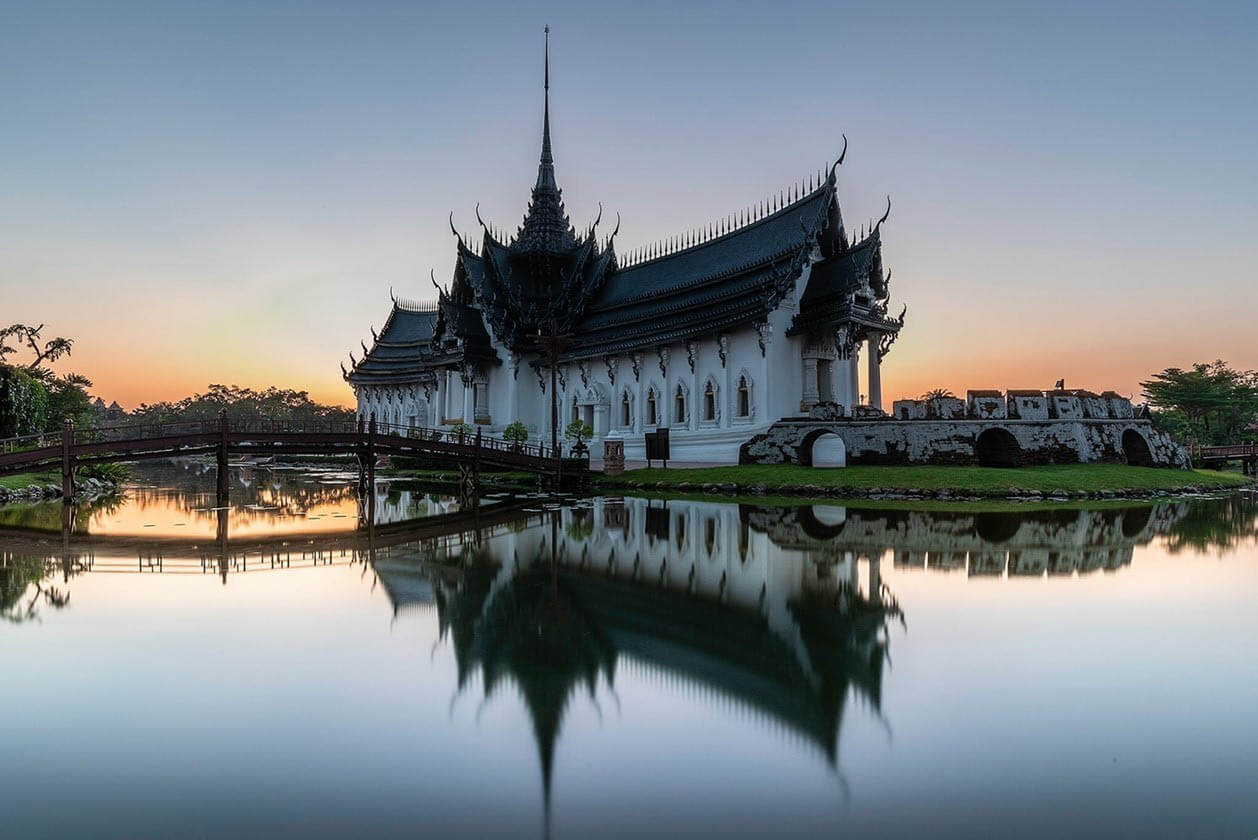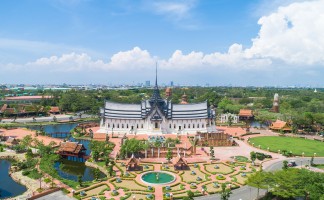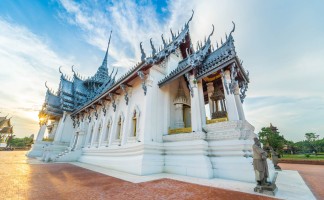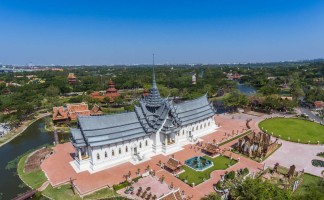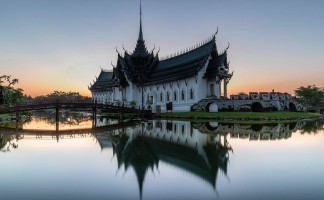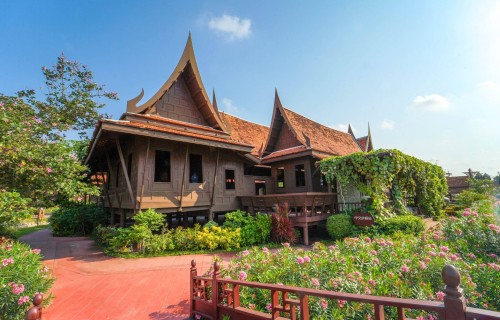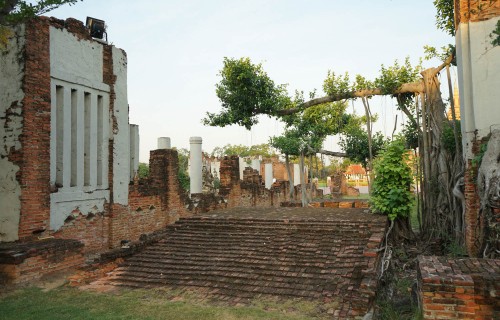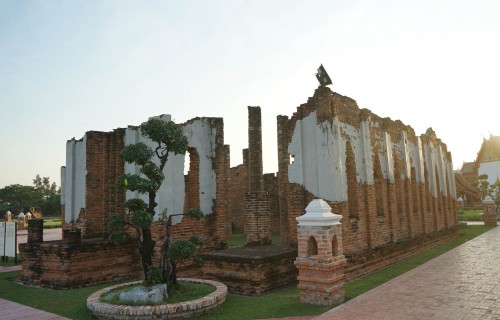Sanphet Prasat Palace (27)
- Information
The Sanphet Prasat Palace was the principal palace in the early Ayutthaya period. It was initially built in the reign of King Baromatrai Lokanat, the eighth king of Ayutthaya. He succeeded in designing a unique architectural style that obviously differed from the preceding Khmer and Sukhothai styles. The distinctive artistic style was later known as the Ayutthaya school which appeared in many parts of the Sanphet Prasat Palace: the sweep of the basement, the tapering pillars, the elaborate pinnacle ornaments, the pedimented door and window frames and the overlapping roof slopes.
The Sanphet Prasat Palace was used in many important court and state ceremonies. For example, it served as a reception hall to receive many foreign dignitaries. The palace was completely renovated in the reign of King Baromakot (1732-1758 A.D.) Unfortunately, when Ayutthaya fell to Burma in 1767 A.D., the stately palace was burnt to the ground. Only its raised brick basement remains today The Ancient City has rebuilt the Sanphet Prasat Palace based on archaeological and historical evidence left by Thai and foreign historians. Also, research was conducted on the ruins to assemble a draft plan of the building. The detailed design and ornaments of the building were executed based on historical remains and documents as well. A proper study on the design of the interior had also been carried out. The result is superb magnificence. The important characteristics of the palace are given as follows:
The Overall Structure and Decorations of the Building the cruciform of Sanphet Prasat Palace is formed by the core of the building, a tall cube rabbeted at each angle, and two wings adjacent to both sides of the central hall. The front and back wings are in fact large halls, but the effect is that of porches abutting a central tower. The largest porch, i.e., the front hall, was for the military and government while the rear hall was for the women of the palace. The other two porches on the left and right are quite short.
The raised basement carries lotus mouldings which dip in the middle and, like the hall of a sailing ship, rise at the ends The structure and style of roof was taken from the old pulpits and such-like furniture in the main (western) hall of Wat Phra Buddha Chinnarat, Phitsanulok Province. The roofs and roof spires are modeled after those of the Aphon Phimoke Palace within the Grand Palace in Bangkok; the roofs over the wing as well as the spire and the spired roof that rises above the central room, its double series of lotus mouldings above seven diminutive stories with their false gables and their naga eaves rackets and fascia boards, are all sheathed with tin plate, as are the roofs over the wings, the short turned posts along the four ridges, the naga bargeboard over the gables and even the ends of the roof purlins The hornlike finial on the roof ridge or chau fa at the extremities of the ridge lines as well as the The hall gables naga bargeboards are from Wat Pho , Bangkok. The eaves brackets are those of Wat Sala Pun in Ayutthaya Province. The stucco gable panels above the palace's porches are based on the stucco gables from Wat Khao Bandai It, Phetchaburi Province.
The Mother of Pearl inlaid doors and windows follow those of the mondop over the Buddha's Footprint at Phra Buddha Bat in Saraburi Province. The ornamental door and window frames, their reduced counterparts on the imaginary gables of the multitiered spire and the palace spire itself are modeled after Wat Khao Bandai It, Phetchaburi Province as well as the large assembly hall from the Ayutthaya period at Wat Maha That in Nakhon Si Thammarat Province. The plaster ornamentation follows the motifs of the prang Wat Chulamani in Phitsanulok Province, which were carried out during the reign of King Baromatrai Lokanat.
The basement plaster ornamentation for the reconstructed palace was inspired by examples from Wat Sa Bua at the foot of Khao Wang Hill in Phetchaburi Province. The two pairs of heraldic ions or singha at the foot of the steps leading to the palace are in the style of Wat Thamikarat in Ayutthaya Province.
The Palace Interior the interior wall decorated with stucco derived from Wat Nang Phaya in the old town of Muang Si Satchanalai, Sukhothai Province. The four posts have also been gilded and inlaid with mirrored mosaic. The central ceiling panel is derived from woodcarving at the Sukhothai National Museum - a wooden ceiling panel from Wat Phra Baromthat at Muang Chalieng. The "moon and the stars" motif carried by the four wings' ceilings are influenced by those at Wat Maha That, Chalieng in Sukhothai Province and Wat Na Phra Meru in Ayutthaya Province. The mural paintings in the central chamber depict the story of "The Ten Reincarnations of Vishnu" as described in an Ayutthaya chronicle. The raised throne was once placed in the hall. It rose in three steps and was sheathed with gold and encrusted with precious gemstones. (It was moved to Ava by the Burmese in 1767 A.D.) The palace was used in many important state ceremonies. The palace hall was the room where Chavalier de Chaumont presented his credentials on behalf of Louis XIV and of which de la Loubère, his aide, had given a vivid description. In the early Rattanakosin era, King Rama I had Indra Phisek Palace Hall modeled after the Sanphet Prasat. Unfortunately, the Indra Phisek was burnt down in a huge fire and Dusit Maha Prasat Palace was built on the same site but by a different plan.
The Sanphet Prasat at Muang Boran was once used as a reception hall by His Majesty the King to welcome Queen Elizabeth II and her consort on February 11, 1972. That day is considered the official opening day of The Ancient City.
The Sanphet Prasat Palace was used in many important court and state ceremonies. For example, it served as a reception hall to receive many foreign dignitaries. The palace was completely renovated in the reign of King Baromakot (1732-1758 A.D.) Unfortunately, when Ayutthaya fell to Burma in 1767 A.D., the stately palace was burnt to the ground. Only its raised brick basement remains today The Ancient City has rebuilt the Sanphet Prasat Palace based on archaeological and historical evidence left by Thai and foreign historians. Also, research was conducted on the ruins to assemble a draft plan of the building. The detailed design and ornaments of the building were executed based on historical remains and documents as well. A proper study on the design of the interior had also been carried out. The result is superb magnificence. The important characteristics of the palace are given as follows:
The Overall Structure and Decorations of the Building the cruciform of Sanphet Prasat Palace is formed by the core of the building, a tall cube rabbeted at each angle, and two wings adjacent to both sides of the central hall. The front and back wings are in fact large halls, but the effect is that of porches abutting a central tower. The largest porch, i.e., the front hall, was for the military and government while the rear hall was for the women of the palace. The other two porches on the left and right are quite short.
The raised basement carries lotus mouldings which dip in the middle and, like the hall of a sailing ship, rise at the ends The structure and style of roof was taken from the old pulpits and such-like furniture in the main (western) hall of Wat Phra Buddha Chinnarat, Phitsanulok Province. The roofs and roof spires are modeled after those of the Aphon Phimoke Palace within the Grand Palace in Bangkok; the roofs over the wing as well as the spire and the spired roof that rises above the central room, its double series of lotus mouldings above seven diminutive stories with their false gables and their naga eaves rackets and fascia boards, are all sheathed with tin plate, as are the roofs over the wings, the short turned posts along the four ridges, the naga bargeboard over the gables and even the ends of the roof purlins The hornlike finial on the roof ridge or chau fa at the extremities of the ridge lines as well as the The hall gables naga bargeboards are from Wat Pho , Bangkok. The eaves brackets are those of Wat Sala Pun in Ayutthaya Province. The stucco gable panels above the palace's porches are based on the stucco gables from Wat Khao Bandai It, Phetchaburi Province.
The Mother of Pearl inlaid doors and windows follow those of the mondop over the Buddha's Footprint at Phra Buddha Bat in Saraburi Province. The ornamental door and window frames, their reduced counterparts on the imaginary gables of the multitiered spire and the palace spire itself are modeled after Wat Khao Bandai It, Phetchaburi Province as well as the large assembly hall from the Ayutthaya period at Wat Maha That in Nakhon Si Thammarat Province. The plaster ornamentation follows the motifs of the prang Wat Chulamani in Phitsanulok Province, which were carried out during the reign of King Baromatrai Lokanat.
The basement plaster ornamentation for the reconstructed palace was inspired by examples from Wat Sa Bua at the foot of Khao Wang Hill in Phetchaburi Province. The two pairs of heraldic ions or singha at the foot of the steps leading to the palace are in the style of Wat Thamikarat in Ayutthaya Province.
The Palace Interior the interior wall decorated with stucco derived from Wat Nang Phaya in the old town of Muang Si Satchanalai, Sukhothai Province. The four posts have also been gilded and inlaid with mirrored mosaic. The central ceiling panel is derived from woodcarving at the Sukhothai National Museum - a wooden ceiling panel from Wat Phra Baromthat at Muang Chalieng. The "moon and the stars" motif carried by the four wings' ceilings are influenced by those at Wat Maha That, Chalieng in Sukhothai Province and Wat Na Phra Meru in Ayutthaya Province. The mural paintings in the central chamber depict the story of "The Ten Reincarnations of Vishnu" as described in an Ayutthaya chronicle. The raised throne was once placed in the hall. It rose in three steps and was sheathed with gold and encrusted with precious gemstones. (It was moved to Ava by the Burmese in 1767 A.D.) The palace was used in many important state ceremonies. The palace hall was the room where Chavalier de Chaumont presented his credentials on behalf of Louis XIV and of which de la Loubère, his aide, had given a vivid description. In the early Rattanakosin era, King Rama I had Indra Phisek Palace Hall modeled after the Sanphet Prasat. Unfortunately, the Indra Phisek was burnt down in a huge fire and Dusit Maha Prasat Palace was built on the same site but by a different plan.
The Sanphet Prasat at Muang Boran was once used as a reception hall by His Majesty the King to welcome Queen Elizabeth II and her consort on February 11, 1972. That day is considered the official opening day of The Ancient City.
